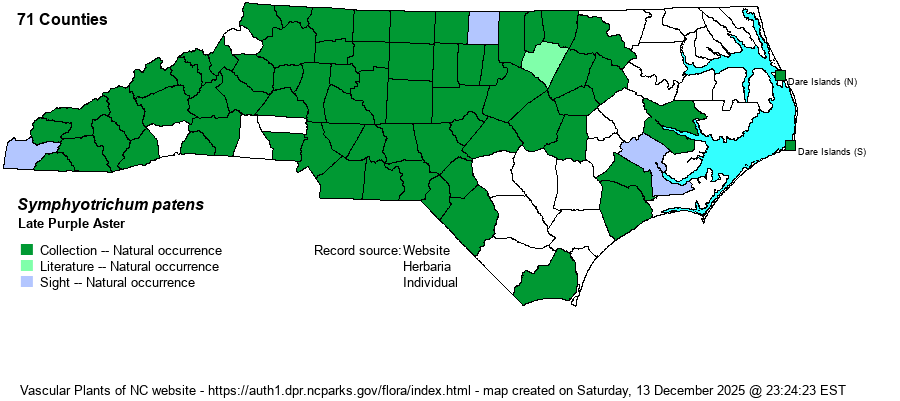| Author | (Aiton) Nesom | |
| Distribution | Mountains, Piedmont, extreme upper Coastal Plain, and Sandhills; disjunct to the outer Coastal Plain and Outer Banks. The gap in the central Coastal Plain appears to be real.
VT to southern IN and eastern KS, south to northern FL, MS, and TX. | |
| Abundance | Generally common across the Mountains and Piedmont. Fairly common in the extreme western Coastal Plain and Sandhills, but uncommon in part of the lower Coastal Plain, and rare on the Outer Banks. Seems to be declining in much of the Piedmont in recent years owing to poor management of powerline clearings and roadbanks, plus spread of taller composites. | |
| Habitat | Dry pine-deciduous woodlands, loamy-sand soils of Longleaf Pine-oak-Wiregrass uplands, bluffs, rocky slopes, openings in maritime forests, roadside banks, wooded margins and openings. Generally prefers partial shade, and not usually found in large open areas. | |
| Phenology | Flowering and fruiting late August - early November. | |
| Identification | Late Purple Aster grows 2-4 feet tall, and the stems are generally unbranched. Stem leaves are elliptical and strongly clasp the stem (auriculate). The inflorescence is open and features horizontally-spreading branches terminated by heads with pale violet, blue-violet, or bluish rays and yellow disks. Georgia Aster (S. georgianum) is colonial from horizontal rhizomes, middle and upper leaves are sessile but not strongly clasping the stem (vs. clasping with leaf tissue around most or all of the stem), has longer and more violet or purple-colored rays (vs. more bluish), and white disk florets (vs. yellow). From S. phlogifolium it differs in its thicker-textured leaves (vs. thin or soft in this latter species), and smaller upper stem leaves (maximum of 2 inches vs. 3 inches or more). Late Purple Aster is a familiar species except in the Coastal Plain, being a commonly seen bright violet-blue flowered aster of dry wooded margins and openings. | |
| Taxonomic Comments | NOTE: The genus Aster was examined by G.L. Nesom (1994), who determined that it was composed of a number of discrete genera (a few of which were already split off by authors as Sericocarpus, Ionactis, etc.). The earliest available name for North American "Aster" is Symphyotrichum, a name regrettably long and hard to spell.
Only the nominate variety -- patens -- is proven to occur in NC. In a 2014 journal paper, Campbell and Seymour described var. terranigrum from the Black Belt of AL and MS; allegedly with several scattered records east of the Appalachians. These odd disjunctions must be double-checked before admitting to the NC flora,
| |
| Other Common Name(s) | Clasping Aster, Spreading Aster, Skydrop Aster | |
| State Rank | S5 | |
| Global Rank | G5 | |
| State Status | | |
| US Status | | |
| USACE-agcp | | |
| USACE-emp | | |

